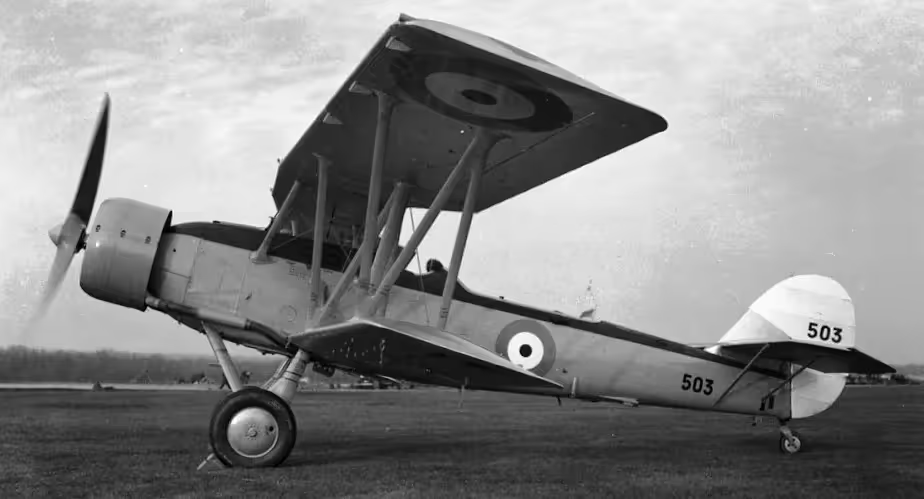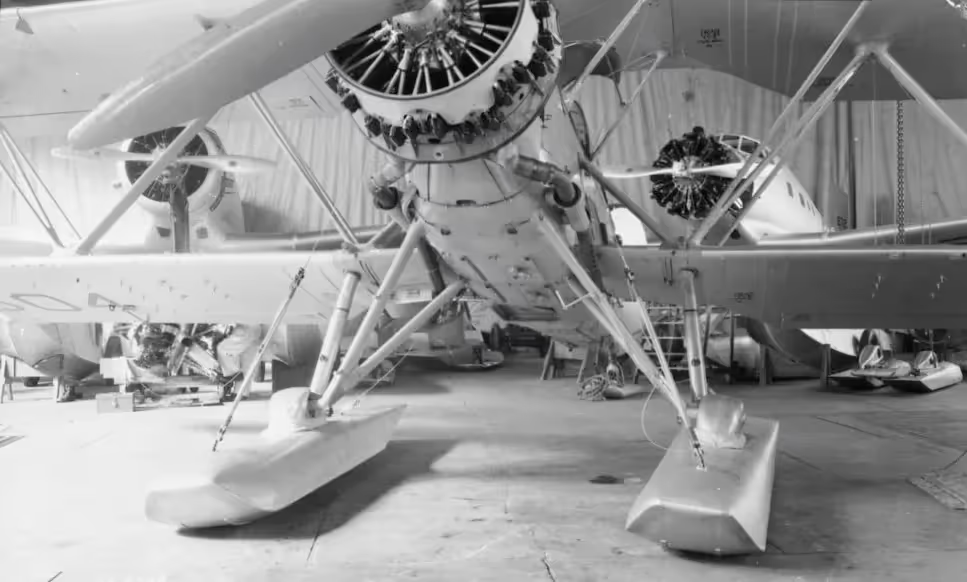Canadian Warplanes 1: Boeing Aircraft of Canada (Blackburn) Shark
Boeing Aircraft of Canada (Blackburn) Shark

(Library and Archives Canada Photo, MIKAN No. 3208198)
Blackburn Shark Mk. III, RCAF (Serial No. 525), No. 6 (Torpedo Bomber) Squadron, May 1939.
The Blackburn Shark was a carrier-borne torpedo bomber built in the UK. It first flew on 24 August 1933 and went into service with the Royal Navy's Fleet Air Arm, the RCAF and the Portuguese Navy. Obsolescent in 1937, it was replaced in the UK by the Fairey Swordfish. The RCAF purchased seven Blackburn Shark Mk. II (powered by 760 hp/570 kW Tiger VI engines) in 1936 for service with No. 6 (Torpedo Bomber) Squadron, later operating as No 6 (BR) Squadron on shipping patrols off the Canadian west coast. Two Blackburn Shark Mk. IIIs (800 hp/600 kW Pegasus III) were supplied to the RCAF by Blackburn in 1939 as forerunners of 17 similar aircraft built by Boeing Aircraft of Canada at Vancouver, with 840 hp (630 kW) Pegasus IX and used by Nos. 6 and 4 (BR) Squadrons.
RCAF Blackburn Sharks, some of which operated as floatplanes, were withdrawn from service in August 1944. It has been reported that five were transferred to the RN Air Observers' School in Trinidad, but this is incorrect, as it wouldn't have made sense to ferry or ship five obsolete aircraft from Canada's west coast all the way to Trinidad so late in the war. Sharks were indeed in Trinidad but delivered much earlier from RN stocks. The five RCAF aircraft were instead delivered (one each) to five small escort carriers built on the Pacific Coast for the Royal Navy. These carriers were: HMS Puncher, HMS Thane, HMS Patroller, HMS Ranee and HMS Reaper. The Sharks were used to train the newly assembled carrier crews in aircraft handling, emergency / practice drills, etc before they received other aircraft types. The airframes were eventually dumped overboard when no longer needed and were also used for target practice. See: http://www.royalnavyresearcharchive.org.uk/.../index.htm.... The RCAF Blackburn Sharks will be a forthcoming profile in the Kestrel Aerospace Publication series.
HMS Puncher and HMS Nabob were crewed by RCN crews to establish the knowledge base for the future carriers assigned to Canada. HMS Thane operated in the North Atlantic protecting convoys and ferrying aircraft for use in the European Theater. On 15 January 1945, while ferrying aircraft in the Irish Sea, she was torpedoed by the German U-boat U-1172 and severely damaged. She was scrapped shortly after. HMS Patroller operated in the Atlantic on convoy escort and patrol duty, with brief stints as a transport carrier for both the Army and Navy. HMS Ranee was one of the 38 converted C3 escort carriers transferred to the United Kingdom. She joined the merchant aircraft carriers guarding the Atlantic convoy routes. HMS Reaper served with the Royal Navy from 18 February 1944 to 13 May 1946.
HMS Reaper was allocated to participate in Operation 'Seahorse', the retrieval portion of Operation 'Livery'. the allied operation to recover top secret German aircraft and weapons from Europe. HMS Reaper was due to make an Atlantic crossing on route to the Panama Canal on her voyage to Australia and so she was the ideal vessel to ferry the captured airframes. Sailing on 12 July 1945, she proceeded to Cherbourg to begin loading.
Operation 'Lusty' had commenced on 22 April 1945, and involved USAAF Intelligence Service personnel scouring Europe searching for top secret German aircraft and weapons, along with other technical and scientific intelligence, to be taken back to the US for study. The Searchers, nicknamed "Watson's Whizzers" (after their CO) located many airworthy aircraft, including nine Me 262 jet aircraft at Lechfeld, and other secret weapons and materials. in total Operation 'Lusty' had acquired 16,280 items (6,200 tons) of equipment and other materials which were transported to Cherbourg for the voyage to the US under the code name operation 'Seahorse'. For this operation two vessels were loaded at Cherbourg, HMS Reaper and the liberty ship USS Richard J. Gatling. HMS Reaper was to ferry the recovered German airframes, the last of which had arrived at Cherbourg on 8 July 1945 these were cocooned before being secured as deck cargo on the flight deck.
HMS Reaper embarked 40 ex-Luftwaffe airframes which included ten Messerschmitt Me 262; five Focke-Wulf Fw 190F; four Focke-Wulf Fw 190D; one Focke-Wulf Ta 152H; four Arado Ar 234B; three Heinkel He 219 Uhu; three Messerschmitt Bf 109; two Dornier Do 335 Pfeil; two Bücker Bü 181 Bestmann; one Doblhoff WNF 342 helicopter; two Flettner Fl 282 helicopters; one Junkers Ju 88G; one Junkers Ju 388; one Messerschmitt Bf 108 Taifun; and one USAAF North American P-51 Mustang.
HMS Reaper also accommodated the intelligence staff and searchers as passengers.. She sailed form Cherbourg bound for New York on July 19th, 1945 and docked at pier 14, New York Harbour on July 31st. HMS Reaper's cargo was then off- loaded by crane onto barges which were towed to a canal that bordered loaded Ford Field, an Air Material Command facility in Newark, New Jersey where another large crane lifted each aircraft to the hard standing. These aircraft went to Dayton, Ohio.
Blackburn Shark Mk. II (7), (Serial Nos. 501, 502, 503, 504, 505, 506, 507); and Shark Mk. III (19), (Serial Nos. 514, 515, 516, 517, 518, 519, 520, 521, 522, 523, 524, 525, 526), Boeing Aircraft of Canada Shark Mk. III (Serial Nos. 545, 546, 547, 548, 549, 550), for a total of 26 aircraft.

(RCAF Photo)
Blackburn Shark Mk. II, RCAF (Serial No. 501).
No. 6 Squadron was established on 4 March 1936 as a Torpedo Bomber unit at Trenton, Ontario. Operating Blackburn Shark biplanes, they were soon moved to the West Coast. Trained to defend Canada against marauding enemy warships through the use of air-dropped torpedoes, they were a concrete manifestation of Canada’s rearmament program in the face of increased tension in the lead up to the Second World War.
The Sharks were equipped with floats, which allowed the RCAF to operate them from the many inlets and coves along the British Columbian coast, where mountainous terrain impeded the construction of airstrips.
When war broke out, the Sharks were re-equipped for anti-submarine and reconnaissance duties. Re-designated No. 6 (Bomber Reconnaissance) Squadron, the unit put away its torpedoes, and anti-submarine bombs were installed in their place. Their mission was to keep an eye out for Japanese submarines and attack them should any be found.
No. 6 (BR) Squadron reached a maximum strength of 15 Sharks by February 1940. Although the first few aircraft were built by the original British plants, most of them were built in Boeing’s factory in Vancouver. They became stationed on the south shore of Skidegate Inlet, at Alliford Bay, an RCAF station built from scratch on the isolated Pacific coast of the Haida Gwaii (Queen Charlotte Islands). Throughout the first years of the war, the Sharks were used for many more duties than just patrolling for Japanese warships. They were also a welcomed addition to the scattered civilian communities and villages all along the West Coast. The floatplanes were used to deliver injured workers to hospitals, support police operations, and many other miscellaneous tasks not originally envisioned for a squadron initially created to torpedo enemy ships. (Valour Canada, Military History Library)

(Library and Archives Canada Photo, MIKAN No. 3583642)
Blackburn Shark Mk. II, RCAF (Serial No. 502), No. 6 (Torpedo Bomber) Squadron, 8 Dec 1944.

(Library and Archives Canada Photo, MIKAN No. 3203457)
Blackburn Shark Mk. II, RCAF (Serial No. 502), No. 6 (Torpedo Bomber) Squadron, May 1937.

(Library and Archives Canada Photo, MIKAN No. 3545879)
Blackburn Shark Mk. II, RCAF No. 6 (Torpedo Bomber) Squadron, May 1939.

(Library and Archives Canada Photo, MIKAN No. 3545880)
Blackburn Shark Mk. II, RCAF (Serial No. 503), No. 6 (Torpedo Bomber) Squadron, May 1939.

(Library and Archives Canada Photo, MIKAN No. 3545931)
Blackburn Shark Mk. III, RCAF No. 6 (Torpedo Bomber) Squadron, May 1940.

(Library and Archives Canada Photo, MIKAN No. 3581009)
Blackburn Shark Mk. II, RCAF (Serial No. 503), RCAF Station Rockcliffe, Ontario, 7 Nov 1936.

(Library and Archives Canada Photo, MIKAN No. 3232302)
Blackburn Shark Mk. II, RCAF (Serial No. 503), RCAF Station Rockcliffe, Ontario, 7 Nov 1936.

(Library and Archives Canada Photo, MIKAN No. 3642455)
Blackburn Shark Mk. II, RCAF (Serial No. 503), RCAF Station Rockcliffe, Ontario, 7 Nov 1936.

(Library and Archives Canada Photo, MIKAN No. 3581010)
Blackburn Shark Mk. II, RCAF (Serial No. 503),RCAF Station Rockcliffe, Ontario, 7 Nov 1936.

(Library and Archives Canada Photo, MIKAN No. 3241747)
Blackburn Shark Mk. II, RCAF (Serial No. 504), with hood. 15 March 1938.

(Library and Archives Canada Photo, MIKAN No. 3642460)
Blackburn Shark Mk. II, RCAF (Serial No. 504), on skis.

(Library and Archives Canada Photo, MIKAN No. 3642461)
Blackburn Shark Mk. II, (RCAF Serial No. 504), on skis, 15 March 1938.

(RCAF Photo)
Blackburn Shark Mk II floatplane (Serial No. 505), RCAF Statino Trenton, Ontario, ca. 1940.

(RCAF Photo)
Blackburn Shark Mk. III (Serial No. 508), on a compass turntable at Brough, England before being shipped to Canada where it became RCAF (Serial No. 525), with No. 6 (Torpedo Bomber) Squadron, 1938.

(Library and Archives Canada Photo, MIKAN No. 3545930)
Blackburn Shark Mk. III, RCAF (Serial No. 523), coded XE-L, No. 6 (Torpedo Bomber) Squadron, Rose Harbour, May 1940.

(Library and Archives Canada Photo, MIKAN No. 3545873)
Blackburn Shark Mk. III, RCAF (Serial No. 525), No. 6 (Torpedo Bomber) Squadron, May 1939.

(BAe Systems Photo)
Blackburn Shark Mk. III, RCAF (Serial No. 525), No. 6 (Torpedo Bomber) Squadron, c1939.

(Library and Archives Canada Photo, MIKAN No. 3545877)
Blackburn Shark Mk. III, RCAF (Serial No. 525), No. 6 (Torpedo Bomber) Squadron, May 1939.

(Library and Archives Canada Photo, MIKAN No. 3545876)
Blackburn Shark Mk. III, RCAF (Serial No. 525), No. 6 (Torpedo Bomber) Squadron, with torpedo, May 1939.

(RCAF Photo)
Blackburn Shark Mk. III, RCAF (Serial No. 525), No. 6 (Torpedo Bomber) Squadron, dropping its torpedo, Alliford Bay, British Columbia, ca 1939.

(RCAF Photo)
Blackburn Shark Mk. III, RCAF (Serial No. 548), coded FY-F, No. 6 (Torpedo Bomber) Squadron, British Columbia, ca 1939.





